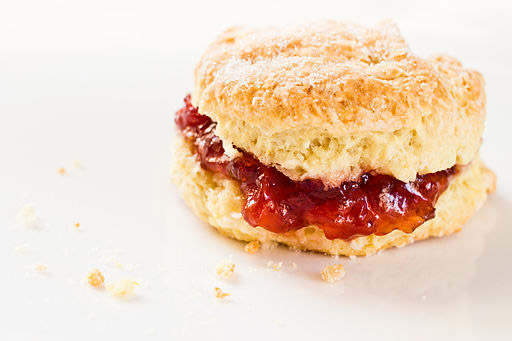I can’t keep writing about life in Cornwall without posting a scone recipe. And not just any scone recipe, an English scone recipe.
You should understand that there’s no single, definitive English scone. Not only do scones divide into plain, fruit, and cheese (or savory, which is spelled savoury), but any one of those three will vary. You can also find griddle scones and drop scones. They’re like the brownie that way. Or religion. Lots of variations; lots of recipes; lots of people damning each other to hell for doing it wrong. You’ll also find regional variations. I could be wrong about this, but I believe scones get larger as they go north. It may have to do with the weather, or the longer O in the northern accents.
Some recipes include eggs, which is any right-living person would tell you is heresy, so this one doesn’t. I have no idea where I found it, or how much I’ve tinkered with it over the years. Whoever developed it, I’d give you credit if I could. All I can give instead is my apologies, and my thanks, because it makes a damned good scone.
Scones: Makes 5 or 6
1 ½ cups flour, unsifted (see below)
1 Tbsp. cold butter
1 Tbsp. sugar
½ tsp. baking soda
1 tsp. cream of tartar
½ tsp. salt
[raisins if you want them]
Enough milk to pull the ingredients into a ball
Sift the dry ingredients. (I was taught to sift flour before measuring, transfer it grain by grain into the measuring cup, then sift it again after measuring, but I can’t be bothered. Half the time I can’t be bothered sifting it at all, I just mix the dry ingredients together. If we’re talking about kitchen heresies, this is a big one, but my baking comes out fine, thanks. Just don’t whack your measuring cup down on the counter to make the flour settle, because it will and you’ll end up with too much.) Cut in the butter. (You want to keep the butter cold, which will keep the scone from being heavy, so if you can cut it with a pastry blender, do. If you use your fingers to crumble it into the dry ingredients, handle it as little as possible.) If you want raisins, this is the time to add them. Stir in just enough milk to form the dough into a ball. Roll out to about ¾” thick on a floured surface and cut with a biscuit cutter or, if you don’t have one, the rim of a glass. If you twist your cutter, the scones won’t rise evenly. If your scones don’t rise evenly, it won’t make the least bit of difference, so don’t lose sleep over this. Place the scones on a greased cookie sheet and bake 12 to 15 minutes at 400 degrees. (To make sure they’re done, take the cookie sheet out of the oven, pry one open partway, and peek inside. If it’s gooey, put the cookie sheet back in for a couple of minutes.) Eat with butter—lots of butter—or jam, or both. They’re fine cold, but they’re better hot.
This is the real thing.


Oh, yum…yuuummmmm…
But I must ask: Are chocolate chips also heresy?
LikeLike
Yup, absolutely: heresy. Not that heresy has to be a bad thing. Toss in a couple of handfuls and live sinfully.
LikeLike
Can I drop them? (before baking, instead of cutting, I mean…..)
LikeLike
I’m not sure it would work. It’s a pretty thick batter. I think you’d have to either roll it out or pat the scones into shape.
LikeLike
According to the scone baking traditions handed down from my grandmother to my mother to me, and which had their origins in the UK, eggs are heresy (as would be chocolate chips!) and cream of tarter the secret ingredient. Yours look delicious.
LikeLike
I’ve made some with cream of tartar and was impressed.
LikeLike
You neatly avoided the hotly contested debate about how jam and cream should be arranged on the scone. And indeed, how the word should be pronounced….There is so much scope for controversy in a scone!
Have you come across the Welsh scone yet? Flat, and full of currants. My mother used to make these, and scotch pancakes (akin to the drop scone) on her inherited ‘griddle pan’ which now lies, discarded amongst the junk that Dad has collected in the garage. I would love to dig it out and give it a life in the third generation, but it looks a little too settled into the category of junk for that. Thanks for taking me down memory lane. Loving your Cornwall anecdotes and episodes.
LikeLike
I have to work up my courage before I address the question of jam and cream, although I can’t avoid it forever, it’s far too important.
I have come across, and made, Welsh scones, but I’m not as good with them as I am with the non-Welsh scone, so I’ll spare everyone my recipe. I settled in the wrong part of Britain to really get a handle on them.
I do hope you manage to rescue the old griddle. I had one back in the US, but it was too heavy to justify shipping. I thought about putting it in my luggage (seriously), but ditto. I also thought about putting it in my backpack, but ditto again. It would’ve been great fun going through security with a heavy whackin’ griddle in my possession. I’m not sure they wouldn’t have confiscated it.
I do miss it.
LikeLike
Nothing like a good scone with clotted cream :~D
LikeLiked by 1 person
Absolutely!
LikeLike
Pingback: Notes from the U.K.